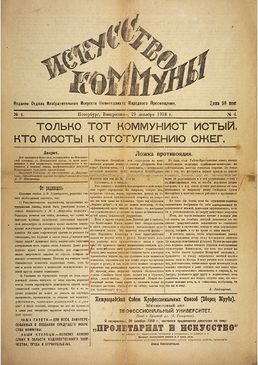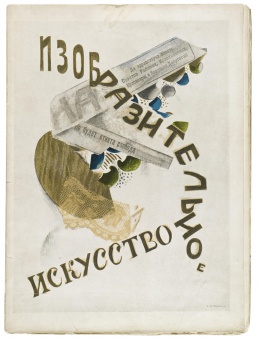IZO Narkompros
Department of Visual [Plastic] Arts [Otdel izobrazitelnykh iskusstv Narkomprosa (IZO); Отдел изобразительных искусств Наркомпроса (ИЗО)] was established in Petrograd on 29 January 1918 as part of the People's Commissariat of Enlightenment (Narkompros), a cultural organization founded in Soviet Russia in November 1917 shortly after the October Revolution, replacing the former Ministry of Culture, and headed by Anatoly Lunacharsky.
- Structure
IZO was run by an Arts Board [Khudozhestvennaya kollegiya] which consisted of the painter David Shterenberg (president), Altman, Vaulin, Karev, Matveev, Punin, Chekhonin and Yatmanov. The board was later joined by Baranov-Rossine, Shkolnik, Mayakovsky (in Aug-Sep 1918), Brik and five architects. A department of IZO was also set up in Moscow and was distinguished from that in Petrograd by its inclusion of a greater proportion of members from the more extreme sections of the avant-garde. It comprised Kuznetsov, Mashkov, Morgunov, Malevich, Zholtovsky, Dymshits-Tolstaya, Rozanova, Shevchenko, Korolev, Konenkov and Kandinsky, under its president and the deputy head of IZO, Tatlin. One source claims the other members were Udaltsova, Nakovsky, Falk, while another mentions Ivanov instead of these three. Co-opted members were Franketti, Fidler and Rodchenko. The Kollegiya was divided into two sections, one deliberative and one executive. Subsections dealt with schools, literature, art and production [khudozhestvennaya promyshlennost'], theatre, cinema, artistic contruction [konstruirovanie], and architecture.[1]
Kandinsky was head of the Purchasing Committee whose members included Malevich, Rodchenko, Liubov Popova, Ivan Kliun, A. Morgunov, et al. [1]
- Exhibitions
IZO organized a series of state exhibitions (twenty‐one between 1918 and 1921), administered the new art schools (SVOMAS/VkHUTEMAS) and research institutes (INKhUK), and was involved in public commissions. Many avant-garde artists and critics were involved with IZO Narkompros in one way or another. [2]
- Publications
IZO published several short-lived journals. Between 7 December 1918 and April 1919, it printed 19 issues of the newspaper Iskusstvo kommuny [Искусство коммуны; Art of the Commune] in Petrograd, with Brik, Kushner and Mayakovsky as its main authors; the contributors included Altman, Malevich, Pougny, and Punin. [3] [4]. Between December 1918 and April 1919, eight issues of Iskusstvo [Искусство; Art] were printed in Moscow. In 1919, one issue of its newspaper Izobrazitelnoe iskusstvo [Изобразительное искусство] was published in Petrograd, with Punin, Brik, Malevich and Kandinsky in its editorial board. [5] [6] [7] [8]. (see Lodder 1993)
Contents
Literature
- D. Shterenberg, "Otchet o deyatelnosti Otdela izobrazitelnykh iskusstv Narkomprosa" [Отчет о деятельности Отдела изобразительных искусств Наркомпроса], Izobrazitelnoe iskusstvo [Изобразительное искусство] 1, 1919, p 50; repr. in Obzor deyatelnosti Otdela izobrazitelnykh iskusstv, Petrograd, 1920, pp 3-9. (Russian)
- Obzor deyatelnosti Otdela izobrazitelnykh iskusstv [Обзор деятельности отдела изобразительных искусств. Народный комиссариат по просвещению], Petrograd, 1920, 118 pp. (Russian)
- A.V. Lunacharsky, "Ob otdele izobrazitelnykh iskusstv" [Об отделе изобразительных искусств] [c1920], in Lunacharsky, Ob iskusstve, 2 [Об искусстве. Том 2], Moscow: Iskusstvo, 1982. (Russian)
- Christina Lodder, "Artists in Administration", in Lodder, Russian Constructivism, Yale University Press, 1983, pp 48-50. (English)
- Christina Lodder, "Art of the Commune: Politics and Art in Soviet Journals, 1917-20", Art Journal 52(1): "Political Journals and Art, 1910-40", College Art Association, Spring 1993, pp 24-33. (English)
Notes
- ↑ Lodder 1983: 49.

